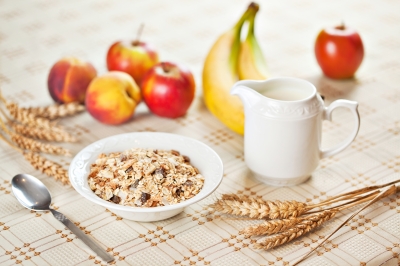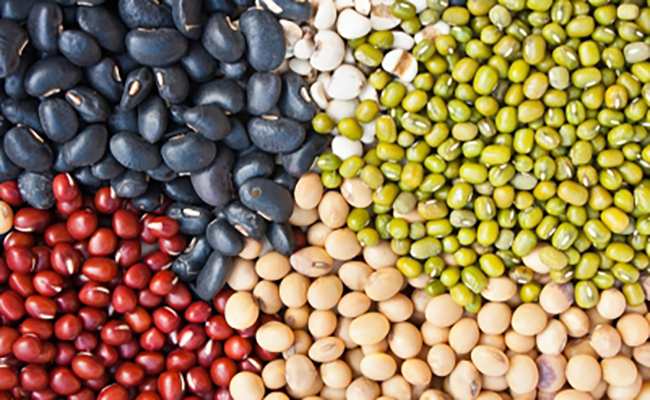4 Reasons Why You Need More Fiber
 How many grams of fiber do you consume daily?
How many grams of fiber do you consume daily?
Most Americans consume half the recommended dietary intake of 25 grams (women) to 38 grams (men) of fiber daily for adults 50 years or younger. Over the age of 50, women should consume 21 grams of fiber and men 30 grams per day.
There are two types of fiber.
Soluble fiber turns to a gel during digestion. Sources of soluble fiber include oats, oatmeal, nuts, seeds, beans, peas, lentils, and some fruits and vegetables (i.e. oranges, apples, carrots).
Insoluble fiber is not digested. It adds bulk to the stool and helps food move through the stomach and intestines. Sources of insoluble fiber include vegetables, whole-grains, and wheat bran.
A diet high in fiber is connected to many health benefits.
- Lower cholesterol levels
Boosting fiber intake from whole-grain products leads to a slower build-up of arterial plaque. Studies also find soluble fiber to protect against atherosclerosis, which is this build-up of plaque in the arterial walls.
Dietary fiber also binds to LDL cholesterol during digestion, resulting in lower LDL cholesterol levels, without decreasing HDL cholesterol levels.
Continue reading
Lower Cholesterol at Every Meal, Every Day

High cholesterol levels increase your risk for heart disease. Felicia D. Stoler, DCN, the author of “Living Skinny in Fat Genes”, shares some fresh ideas on how you can lower cholesterol at every meal.
Lisa Nelson RD: We can now find many grocery options with “cholesterol free” labeling. What does “cholesterol free” mean?
Dr. Stoler: In a nutshell, a food that says it is “cholesterol free” means it has NO animal products in it. It’s a bit misleading… for example, apples can say they are “cholesterol free”.
Lisa Nelson RD: Should consumers disregard “cholesterol fee” labeling? If so, what should they look at instead when selecting heart healthy products?
Dr. Stoler: I always tell people to look at calories, fiber, and fat. If it’s a food that has fiber, does it have the most (across brands) fiber per serving. When it comes to fat, does it have lower fat than other comparable products?
Lisa Nelson RD: What are some great breakfast tips to promote lower cholesterol levels?
The Best Type of Rice to Promote Heart Health
 Rice is frequently consumed in combination with other foods, such as vegetables, beans, and meat. It is a low cost food, so it allows you to stretch your food budget.
Rice is frequently consumed in combination with other foods, such as vegetables, beans, and meat. It is a low cost food, so it allows you to stretch your food budget.
There are many varieties of rice, many of which you are probably not familiar with, such as Arborio, black, red, jasmine, basmati, and then the more common wild, brown, and white.
All rice provides a variety of nutrients, including carbohydrates and protein. Plus, rice is gluten free. A one cup serving of wild rice even contains 156 mg of omega 3 fatty acids to help promote heart health and lower cholesterol.
The two most common include white rice and brown rice, so let’s by compare these two options.
White Rice vs. Brown Rice
Continue reading
What equals 25 – 35 grams of dietary fiber?

I recently had an individual email me the following question:
How much fiber do I need to eat to equal 25 grams? How many pieces of fruit, slices of bread, cups of barley or flaxseed? I can’t relate to 25 grams.
I want to share the answer with everyone. Read on. . .
How Much Dietary Fiber
You need to consume between 25-35 grams of dietary fiber daily. Of this, soluble fiber should make up 15 grams. For every 1-2 grams of daily soluble fiber intake, LDL (bad) cholesterol is lowered 1%.
The average US dietary fiber intake is 12-18 grams/day. If your current diet is very low in dietary fiber, do not increase to 35 grams overnight. A sudden increase will result in gastrointestinal (stomach) distress and unpleasant side effects (flatulence and diarrhea). You want to increase your intake gradually.
Top 5 Foods Containing Dietary Fiber
Lower Cholesterol – Do you understand your lab results?
It’s very possible your MD orders lab work and you have no idea what or why you’re having blood drawn. Well, let’s clear up the confusion when it comes to your cholesterol labs.
The terms “lipid panel”, “lipid profile”, and “lipoprotein profile” are used interchangeably to order the same set of labs. To make reading this easier, I’m going to use “lipid profile” from here on out.
“Lipid” is simply a medical term for “fat”. A lipid profile measures fatty substances in your blood. Cholesterol is one type of fat.
When you eat food containing cholesterol or when your body produces cholesterol and releases it into your bloodstream, the cholesterol will attach to a protein. This package of cholesterol plus a protein is called a lipoprotein (lipid or fat plus protein). A lipid profile measures lipoprotein levels in your blood.
Lipid profiles include five components:
LDL – “bad” cholesterol
LDL (low-density lipoprotein) cholesterol carries mostly cholesterol, some protein, and minimal triglyercerides throughout your circulation. LDL should be less than 130 mg/dL, ideally less than 100 mg/dL.
VLDL – “bad” cholesterol
VLDL (very low-density lipoprotein) cholesterol contains minimal protein and mainly transports triglycerides. VLDL should be less than 40 mg/dL.
Triglycerides
Triglycerides are a type of fat in the blood, not a type of cholesterol. Triglycerides are frequently used to estimate VLDL (“bad”) cholesterol. Here’s the calculation: triglycerides divided by 5 equals VLDL cholesterol. Triglycerides should be less than 200 mg/dL, ideally less than 150 mg/dL.
HDL – “good” cholesterol
HDL (high-density lipoprotein) cholesterol removes cholesterol from your bloodstream and carries it back to the liver. I like to think of HDL as a vacuum cleaner, picking up cholesterol LDL leaves behind in your arteries, the more HDL the better. HDL should be greater than 40 mg/dL, ideally greater than 60 mg/dL.
Total cholesterol
Cholesterol is essential to bodily functions, such as building cells and producing hormones. However, too much cholesterol will build up on artery walls, form a plaque, and potentially “plug” the artery resulting in a heart attack or stroke. Total cholesterol is calculated from the above components (Total cholesterol = HDL + LDL + VLDL). Total cholesterol should be less than 200 mg/dL.
Do you see how if you only know your total cholesterol, you only have one piece of the lipid profile?
Now, sometimes your results will include ratios or a risk score. Here’s an explanation of what those numbers mean.
Risk Score
A risk score is based on you lipid profile results, sex, age, family history, and various other risk factors. If you have a high risk score for heart disease, it’s best to speak with your MD to evaluate your risk score.
Cholesterol:HDL Ratio
You want a low ratio of cholesterol to HDL. A ratio lower than 4.5 is good, but 2 or 3 is best. You can calculate your cholesterol to HDL ratio by dividing total cholesterol by HDL. For example, your total cholesterol is 195 and your HDL is 55. 195 divided by 55 equals a ratio of 3.5.
It’s actually not your total cholesterol that has the greatest impact on your heart disease risk. The ratio of total cholesterol to HDL is a critical factor. If your total cholesterol is less than 200, but your ratio is 5, you are still at increased risk for developing heart disease.
LDL:HDL Ratio
This ratio compares the amount of bad (LDL) cholesterol to your good (HDL) cholesterol levels. You want a ratio less than 3.5, ideally less than 2.5. To calculate your ratio, divide LDL by HDL. For example, your HDL is 55 and LDL is 100. 100 divided by 55 equals a ratio of 1.8.
Triglyceride:HDL Ratio
A low ratio of triglycerides to HDL is best, ideally less than 2. To calculate your triglyceride to HDL ratio, divide your triglycerides by your HDL. For example, your triglyceride level is 200 and your HDL is 55. 200 divided by 55 equals a ratio of 3.6.
Lipid profiles are commonly ordered to assess your heart disease risk. Your doctor or dietitian will use the results to determine the best treatment to reduce your risk.
A lipid profile is beneficial, because you know your “good” cholesterol level and “bad” cholesterol levels. The interventions that work best to raise HDL and lower LDL differ, so knowing all your numbers helps you make the most effective changes.
You’re probably wondering why a lipid profile isn’t always ordered versus simply checking your total cholesterol (and possibly HDL). Cost and time always play a part and if your risk for heart disease is low, then a quick and less expensive screening makes sense. If you are at increased risk, a more complete assessment (lipid profile) may be more appropriate. Everyone’s situation is unique, so it’s best to discuss what’s right for you with your MD.
Now, to receive regular heart health and weight loss tips from dietitian Lisa Nelson, subscribe to The Heart of Health today!
All the best,
Lisa Nelson RD
Trans Fats Banned in California
Good news if you live in California! Starting in 2010 restaurants will be banned from using trans fats in food preparation. This will be a major benefit to those of you struggling to lower total cholesterol, low LDL “bad” cholesterol, or raise HDL “good” cholesterol. To improve your lipid profile you should follow a diet with less than 30% daily calories from fat. Ideally your intake of trans fatty acids should be zero for heart health. Since numerous restaurants affected will be nationwide chains, hopefully the trend will start to spread and avoiding trans fats when dining out will not be an issue after a few more years.
All the best,
Lisa Nelson, RD, LN
eNutritionServices



